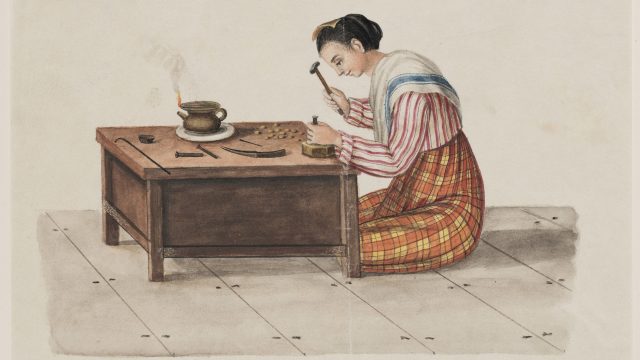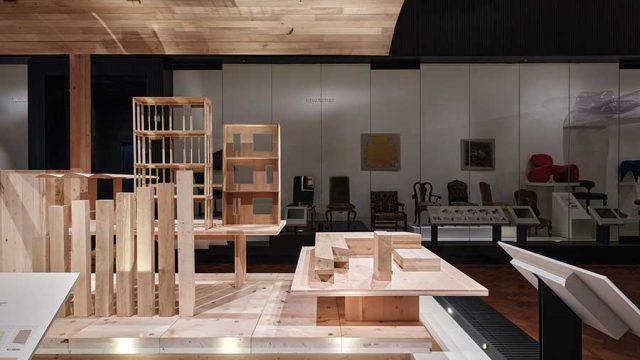The India Museum – a brief Introduction
The India Museum was founded as part of the East India Company (EIC) at the turn of the nineteenth century. Formed for the exploitation of trade with India, East and Southeast Asia, the East India Company was initially created in 1600 to serve as a trading body for English merchants, specifically to participate in the East Indian spice trade. Later, items such as cotton, silk, tea, and opium were added. Although the company had started as a monopolistic trading body, the EIC became involved in politics and acted as an agent of British imperialism in India. Described by William Dalrymple in the Guardian as ‘the world’s first aggressive multinational corporation,’ the EIC at its peak was the largest corporation in the world and came to rule large areas of India, assuming administrative functions and exercising military power.
During its time, the EIC also acquired a substantial number of objects for its India Museum. The museum was located at the Company’s headquarters in Leadenhall Street in the City of London. It is frequently cited as one of the major attractions of late Georgian and Victorian London, yet in recent years, little has been remembered of it beyond its mere existence.

Following the First War of Independence (1857), the East India Company – which had already been reduced to being simply a managing agency for the British government of India from 1834 onwards – ceased to exist as a legal entity in 1873. The objects that had been gifted to, purchased or looted by the East India Company for the India Museum were dispersed in 1879. Around 19,000 of these objects were transferred to the South Kensington Museum, the forerunner of today’s Victoria and Albert Museum (V&A). These objects have now been newly examined by the V&A Research Institute’s Andrew W. Mellon Visiting Professor Arthur MacGregor (b. 1941). In his monograph The India Museum Revisited (2023), MacGregor provides a full examination of the museum’s founding manifesto and evolving ambitions. Extensively illustrated, the volume discusses the museum’s development, its wider impact, and the impressions it formed on the minds of the contemporary public.
A brief history of the India Museum
A resolution of the Court of Directors of the East India Company, dated 25 May 1798, brought into being in the following years a library for ‘oriental writings’ and a parallel collection of artefacts and natural specimens, all housed at the Company’s headquarters in Leadenhall Street. Charles Wilkins (1749 – 1836) was appointed the museum’s first librarian and curator, formally taking up office in 1801.
Wilkins’s vision for the museum encompassed three elements: a ‘cabinet of natural productions’, artificial productions, and ‘miscellaneous articles … generally such things as cannot conveniently be classed under any of the former heads’. From the outset the collections were designed to present both the natural resources that formed the basis of industry and commerce with India, and the manufactured products representing the outputs of Indian manufacture.
By the mid-19th century these interests were given a renewed focus with the advent of the series of international exhibitions of ‘the industries of all nations’, launched by the Great Exhibition of 1851 at the Crystal Palace in Hyde Park. The India Museum was the major contributor to the Indian section of that exhibition, thanks to the energy and organizing ability of its associate curator, John Forbes Royle (1798 – 1858), then a professor at King’s College. The India Museum continued to participate in international exhibitions that followed.

Following the First War of Independence (1857), the company was wound up and the government established a new department – The India Office – which assumed responsibility for all Indian affairs. With the transfer of the East India Company’s assets to the India Office, the utilitarian dimension of the museum was driven forward with renewed vigour by John Forbes Watson (1827 – 1892), appointed as ‘Reporter on the Products of India’ with responsibility for the collections. Under Forbes Watson, directorship of the museum became even more closely involved in the development of commercial relations with India, while at the same time undergoing a series of disruptive relocations. First, the museum moved in 1861 to Fife House in Whitehall following the extinction of the East India Company in 1858, then to the attics of the newly built India Office in 1869, and from 1875 then to the ‘Eastern Galleries’ on the exhibition site to the west of the present Exhibition Road in South Kensington.
Finally, in 1879, the institution ceased to exist as an independent body and the collections were dispersed. In broad terms, the natural history specimens were divided between the Royal Botanic Gardens and the nascent British Museum (Natural History) – today the Natural History Museum – according to their nature. Antiquities and some parts of the ethnographic collections went to the British Museum. The bulk of the manufactured objects, however, were transferred to the South Kensington Museum, forerunner of today’s V&A. It is the latter collections that form the basis of The India Museum Revisited survey.
The India Museum Revisited project is hosted by the V&A and has been supported by the Andrew W. Mellon Foundation. The project’s website presents supporting textual and visual evidence too bulky to be included in the book. These presentations take the form of a series of blogs, to which texts and images and newly emerging information will be added from time to time. Here the project is set in its historical context. Please visit the project page for access to the volume’s accompanying materials.
To order a copy of The India Museum Revisited or to download your free copy, please visit the UCL Press website.


